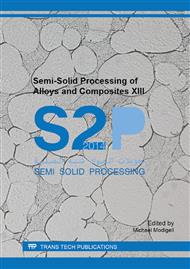p.111
p.121
p.130
p.138
p.144
p.151
p.159
p.166
p.174
Experimental Study and Numerical Simulation on the Blistering Defect during Thixocasting
Abstract:
Blistering is one of the main surface defects of thixocasting parts after solution treatment. In this paper, experimental study about the influence of plunger velocity on blistering problem was carried out, and the blistering level with various velocities was discussed. In addition, a series of simulation work for filling process were performed to analyse the formation mechanism of blister. The results indicate that the power law cut-off model can reflect the thixotropic characteristics better at shear rate range from 100s-1 to 500s-1 than Carreau model. Based on power law cut-off (PLCO) model, the filling process simulation reveals the air entrapments were caused by poor venting instead of turbulence, either decreasing the filling speed or modification of the die venting system would improve blistering problem.
Info:
Periodical:
Pages:
144-150
Citation:
Online since:
September 2014
Authors:
Price:
Сopyright:
© 2015 Trans Tech Publications Ltd. All Rights Reserved
Share:
Citation:


